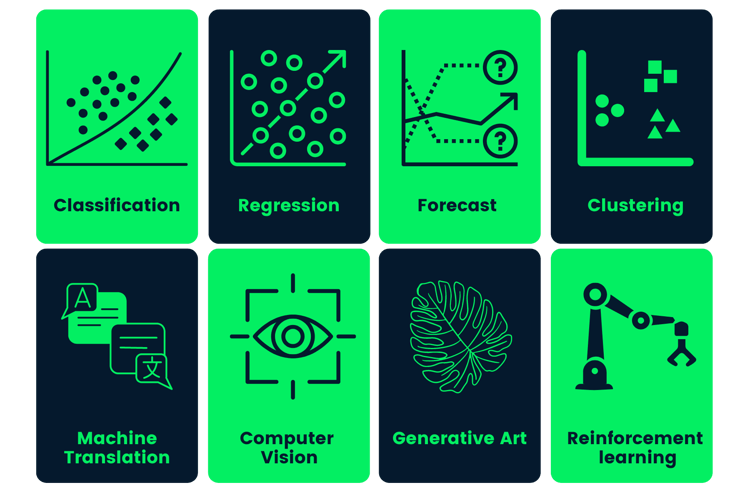Course
This article is a valued contribution from our community and has been edited for clarity and accuracy by DataCamp.
Interested in sharing your own expertise? We’d love to hear from you! Feel free to submit your articles or ideas through our Community Contribution Form.
Artificial Intelligence has become essential for software development in today’s rapidly evolving tech landscape. It enables applications to perform tasks that were once considered the exclusive domain of humans, such as understanding and generating human language, recognizing patterns in data, and making intelligent decisions. From chatbots and recommendation systems to image recognition and natural language processing, AI is transforming how we build software.
As a junior data practitioner with a solid technical foundation, you might wonder how to harness AI’s power effectively. That's why this guide will explore why and how to choose AI frameworks, what frameworks and libraries you should explore, and many other essentials.
AI Upskilling for Beginners
Why Choose an AI Framework?
These days, developers rely on corresponding frameworks and libraries more and more to save money, time, and resources while creating AI-driven software. Let’s consider what AI frameworks and libraries are — a collection of pre-built tools and resources that simplify the process of building applications on the basis of Artificial Intelligence. These frameworks provide a foundation for implementing machine learning and deep learning algorithms, making it easier to develop intelligent software.
Now, let’s discover more about why AI frameworks are used for boosting software development flow.
They are cost-effective for IT companies
AI frameworks provide businesses with a cost-effective way to develop custom software applications. By eliminating the need for manual coding and allowing developers to use pre-built components, frameworks can significantly help businesses reduce their development costs. Using frameworks also allows businesses to quickly build sophisticated applications tailored to their specific needs. By leveraging AI and ML power, companies can develop more efficient software solutions than traditional software development methods.
They facilitate app development flow
When selecting frameworks, it's important to consider their ability to streamline the development process. These frameworks come with pre-implemented algorithms, data handling utilities, and optimization techniques, which enable developers to focus on solving the specific problem at hand rather than getting caught up in the technicalities of AI implementation.
They are a time-saving opportunity
AI frameworks are a tremendous timesaver for modern software development because they simplify creating, testing, and deploying applications. They also provide a complete development environment with debugging tools, testing harnesses, and data visualization capabilities. This speeds up the development process as developers can act quickly without having to manually compile and debug each section of their code. Additionally, AI frameworks offer a wide variety of pre-built models.
These are the most common reasons for implementing AI in business from the very steps of software development for enterprises. Now, let’s consider the key factors when choosing an Artificial Intelligence framework for an IT project.
How to Choose an AI Framework That Fits Your Business Needs
When choosing an AI framework, it's essential to consider several key factors to ensure it aligns with your project's requirements and your level of expertise.
Performance
Performance should be a top priority when looking at frameworks. Opting for a framework that can handle data efficiently and provides rapid training and inference times is recommended. The performance of different frameworks can be assessed by evaluating benchmarks and real-world use cases.
Community support
An active and engaged community is an absolute necessity for the development of AI frameworks. It provides unlimited access to an extensive array of resources, tutorials, and community-driven plugins, along with unwavering support for implementing ongoing enhancements and updates to the framework.
Flexibility
When working on AI projects, flexibility is of utmost importance. The best AI framework that provides the ability to experiment with various algorithms is essential to ensure success. Additionally, the framework should be able to adapt to different data types, such as text, images, and audio, and integrate with other technologies without any issues. Thus, you can ensure that your AI projects are efficient, accurate, and effective.
Ease of learning
It's important to choose a framework that matches your current skill level when starting out as a junior data practitioner. Pay attention to the frameworks that are more beginner-friendly, offering detailed documentation and tutorials. Moreover, consider your learning style and the available resources to aid you in getting started.
When selecting an AI framework, it is crucial to consider various factors, including performance, community support, flexibility, and ease of learning. By doing so, you can ensure that the framework meets the requirements of your project and is compatible with your skill level. Considering these factors will help you find the ideal framework for your data projects.
Open-Source vs. Commercial AI Frameworks: Benefits and Drawbacks
When it comes to choosing the best AI framework for your development project, you have two main options: open-source and commercial frameworks. Each option has its own set of advantages and disadvantages. Understanding the differences between them before making a decision is vital.
Open-source AI frameworks
Open-source frameworks are those released under an open-source license, which grants users the opportunity to operate with the software for any purpose.
Why are open-source frameworks beneficial?
- They're typically free to use, making them budget-friendly for small projects and startups.
- They often have a strong and active community, which can be used as a valuable resource for learning and troubleshooting.
- You can inspect the source code of open-source frameworks, giving you greater control over your AI implementations.
What are the drawbacks of the open-source AI frameworks?
- Limited support. While community support is helpful, it may not be as responsive or comprehensive as commercial support.
- Complexity. Some open-source frameworks can be complex and challenging for beginners to grasp fully.
Commercial AI frameworks
Commercial frameworks are developed by companies that release their software under proprietary licenses. This means that users of these frameworks are limited in what they can do with the software and also may be subject to additional fees. However, users of commercial frameworks may benefit from extra features and support from the vendor.
The benefits of commercial AI frameworks
- Commercial frameworks typically come with dedicated support teams, ensuring prompt assistance when issues arise.
- They often focus on user-friendliness, making them more accessible to developers of all skill levels.
- Moreover, you may find advanced features and optimizations in commercial frameworks that cater to specific use cases.
When figuring out How to learn AI, you need to consider both the positives and negatives of different frameworks.
The drawbacks of commercial AI frameworks
- They can be expensive, which may be prohibitive for small or bootstrapped projects.
- Using a commercial framework may tie you to a specific vendor and limit your flexibility.
Which to choose? The response relies on your particular project needs and requirements. Moreover, when selecting a framework, you should take into account financial resources, personal expertise, and other factors.
The Top AI Frameworks and Libraries
Software is an important component of streamlining business operations through AI frameworks and libraries. By using software, businesses can automate tasks, reduce manual labor, improve accuracy, save time and money, create insights from data, and more.
Popular AI frameworks such as TensorFlow and PyTorch are used for developing machine learning models. These frameworks provide a comprehensive set of tools that enable developers to easily create and deploy ML models. Other useful AI libraries include Scikit-Learn, Keras, and Caffe. These libraries provide a set of APIs that enable developers to quickly develop applications without needing to write an entire code base from scratch.
PyTorch
Torch is an open-source machine learning library known for its dynamic computational graph and is favored by researchers. The framework is excellent for prototyping and experimentation. Moreover, it's empowered by growing community support, with tools like PyTorch being built on the library. PyTorch has swiftly become one of the most widely used frameworks out there, useful in all kinds of applications.
Scikit-Learn
Scikit-Learn is a Python library for machine learning. It is an open-source and beginner-friendly tool that offers data mining and machine learning capabilities, as well as comprehensive documentation and tutorials. Scikit-Learn is well-suited for smaller projects and quick model prototyping but may not be the best choice for deep learning tasks.
TensorFlow
TensorFlow is an open-source deep learning framework developed by Google. It's renowned for its flexibility and scalability, making it suitable for many AI applications. This framework has a large and active community and is equipped with extensive documentation and tutorials.
It also supports deployment on various platforms. However, the learning curve of TensorFlow can be steep for beginners.
Keras
Keras is an open-source high-level neural networks API that runs on top of TensorFlow or other frameworks. It is user-friendly and easy to learn, simplifying the process of operating with deep learning models. Moreover, it's ideal for quick prototyping. You should only keep in mind that Keras may lack some advanced features for complex tasks.
LangChain
LangChain has recently gained popularity as a framework for large language model (LLM) applications. It allows developers to build applications using LLMs with features like model I/O, data connections, chains, memory, agents, and callbacks. LangChain integrates with various tools, including OpenAI and Hugging Face Transformers, and is used for diverse applications like chatbots, document summarization, and interacting with APIs.
Hugging Face
Hugging Face specializes in easy-to-use AI tools, mainly known for their "Transformers" library, which helps in advanced machine learning tasks like language processing and creating chatbots. They also provide tools for generating images and sounds, efficient ways to handle data in AI models, and simple methods to update large AI models. Additionally, they offer web-friendly versions of these tools, making it easier for beginners and experts alike to experiment with AI in various fields, including natural language processing and computer vision.
OpenNN
OpenNN is a tool used for creating neural networks, a type of AI that mimics how the human brain works. It's written in C++ and is known for being fast and efficient. OpenNN is used mainly for research and creating AI that can learn and make decisions based on data.
OpenAI
OpenAI provides a range of tools for different AI tasks, including making images or converting text to speech. It's known for its powerful GPT language models that can understand and generate human-like text. OpenAI's platform is user-friendly, making it easier for people to use advanced AI in their own projects, especially for creating AI assistants or tools that interact with users in natural language. It's worth noting that several of the features required a paid premium subscription.
PyBrain
PyBrain is an open-source ML library for Python. It provides a simple and flexible environment for experimenting with various machine learning algorithms and is perfect for researchers, educators, and developers looking for a lightweight Python-based framework for exploring machine learning concepts.
It is lightweight and easy to use for experimentation, supporting a wide range of machine learning algorithms. Moreover, PyBrain’s AI library is good for educational purposes and rapid prototyping.
However, you should take into account that PyBrain has limited documentation and a smaller community compared to mainstream libraries. It may also lack some advanced features found in other frameworks.
IBM Watson
IBM Watson is a suite of AI and machine learning services provided by IBM. It offers tools and solutions for building and deploying AI-powered applications, including natural language processing, computer vision, and predictive analytics.
It can be easily integrated with IBM Cloud for seamless deployment. What is more, robust AI capabilities in the IBM Watson suite are backed by IBM's expertise. However, the pricing may be a concern for smaller businesses seeking comprehensive AI solutions and consulting services.
Microsoft Cognitive Toolkit (CNTK)
The Microsoft Cognitive Toolkit, or CNTK, is a free and open-source deep learning AI framework developed by Microsoft. It's known for its efficiency, especially on multi-GPU systems, and is suitable for both research and production deployments.
It is preferred by many researchers, data scientists, and developers working on deep learning projects with access to powerful hardware because it's highly efficient, particularly for training large models. It also supports multiple neural network types, including feedforward and recurrent networks; additionally, it provides a Python API for ease of use.
But you should be aware that Microsoft CNTK may possess a steeper learning curve compared to more beginner-friendly frameworks.
DL4J (Deeplearning4j)
Deeplearning4j, often abbreviated as DL4J, implies an open-source deep learning framework specifically designed for Java and Scala developers. It provides a comprehensive set of tools for building and deploying deep neural networks in Java-based applications.
DL4J is designed for Java and Scala, making it suitable for enterprise-level applications. The framework also offers support for distributed computing, enabling scalability. The platform includes a wide range of neural network types and pre-processing tools. However, it has a smaller community compared to Python-based frameworks.

More AI frameworks and libraries to consider
Theano
Theano is an open-source numerical computation AI library for Python. While it's no longer actively developed, it played a significant role in the early days of deep learning.
Why so? For starters, it had an efficient symbolic mathematics library. Theano was also suitable for educational purposes. Although some existing projects may still use it, it's no longer actively maintained or updated.
MXNet
MXNet is an open-source deep learning framework known for its efficiency and scalability. Additionally, MXNet is efficient for both research and production. It has growing community and industry support, but its community is smaller compared to TensorFlow and PyTorch.
Caffe
Caffe is an open-source deep learning framework. It's known for its speed and efficiency in computer vision tasks, supporting a variety of deep learning architectures. Caffe is optimized for computer vision applications and excellent for deploying on edge devices. But when choosing it, you should consider its limited flexibility for non-vision tasks.
XGBoost
This is an open-source gradient boosting framework known for its efficiency and performance. Data practitioners working with structured data and classification/regression problems often choose it.
This AI framework excels in structured data tasks and is widely used in data science competitions. XGBoost is known for its exceptional performance for tabular data. The framework supports various programming languages being well-maintained and actively developed. However, you should understand that XGBoost is not designed for deep learning tasks.
Conclusion
We’ve covered some of the most popular AI frameworks, libraries, and other tools for you to consider. You can also check out our list of the Top 5 AI tools for data science to know more about how to boost the productivity of your data processing workflows.
As a junior data practitioner, choosing one of the right AI frameworks or libraries is crucial for your professional growth and project success. While there's no one-size-fits-all solution, consider your project's requirements, your familiarity with the framework, and the resources available in the community.
In summary, PyTorch and TensorFlow are excellent choices for deep learning projects, with TensorFlow offering scalability and PyTorch emphasizing flexibility. Scikit-Learn is a go-to for traditional machine learning tasks, while Keras provides a user-friendly entry point to deep learning. XGBoost excels in structured data problems, Caffe is a top choice for computer vision, and MXNet offers efficiency and scalability. Remember that Theano, while no longer actively developed, may still find its use in certain educational contexts. More recent tools such as LangChain and OpenAI give excellent options for LLMs, while Hugging Face is useful for natural language processing in general.
Ultimately, the best AI framework or library is the one that aligns with your specific needs and helps you achieve your goals as a data practitioner. So, roll up your sleeves, dive into the world of AI, and start building smarter software with the right tools.
Earn a Top AI Certification

Yuliya Melnik is a technical writer at Cleveroad. It is a web and mobile app development company in Ukraine. She is passionate about innovative technologies that make the world a better place and loves creating content that evokes vivid emotions.



